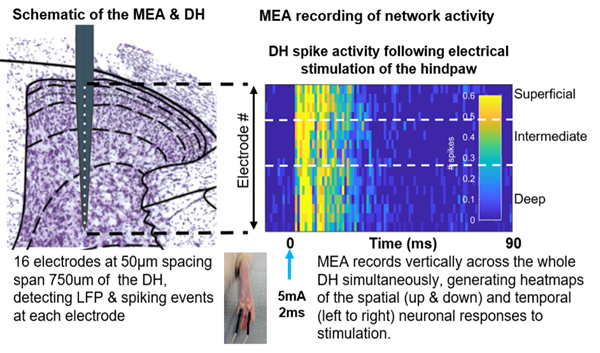Multi-Electrode Array recordings (MEA)

Our research focuses on understanding the role of the dorsal horn (DH) of the spinal cord in pain signalling. The dorsal horn is a key region in pain processing as it integrates ascending input from the body with descending modulation from the brain to set the intensity of pain signals.
The DH is a complex structure comprised of five layers (laminae). Each of these functionally and anatomically distinct layers receives different types of input from the body and other layers, and serves separate roles in pain processing. To try and understand how pain signals are processed in the dorsal horn, we can use recording approaches (electrophysiology) to record the electrical activity of individual cells (neurones). However, traditional methods to record spinal neuronal activity generally rely on recording from one single cell of one type of neurone in just one layer of the DH in each experiment. The activity of this one cell is then used to extrapolate the functional output of the whole DH network. Whilst this approach has provided many useful insights over the years, it lacks detail and fails to account for the vast differences in activity of individual cells, and the complexity in how different cells in different layers contribute to pain processing.
We have recently developed a new approach to record neuronal network activity across the whole of the spinal cord DH simultaneously using multi-electrode arrays (MEAs; https://physoc.onlinelibrary.wiley.com/doi/10.1113/JP277036). The MEA has 16 evenly spaced electrodes (see figure) instead of just one, each of which can detect the activity of multiple cells simultaneously, providing much richer information on the activity of the entire network in both time and space. This means we can now measure how this vital network of nerve cells responds to touch and electrical stimulation of the hind paw in anaesthetised animals, and significantly reduces the number of animals we need to use.
We have recently used this method to explore how DH network responses to painful and non-painful sensory stimulation change with ageing, mapping out both early life development, and changes associated with old age. We used a wide range of touch (mechanical) and electrical stimulations of the hind paw and compared responses in young, adult, and aged rats. Other work includes using MEA recordings to identify how long-term exposure to opioid pain-killers alters DH network responses in early life, and can lead to greater pain later in later life, or following subsequent injury.
If you are interested in the MEA approach and/or our research within Pain Centre Versus Arthritis, please contact Dr Gareth Hathway or Dr Steve Woodhams.